
My parents recently celebrated their 35th wedding anniversary. They decided to go to a lodge near Williamsburg, Virginia to celebrate, but before they left I asked them if they wanted me to make a special dinner. “How about lasagna?” my dad suggested.
So I pulled up this recipe on GialloZafferano.com for Lasagna alla Bolognese, the original, traditional lasagna. According to the recipe, the ragù should take about 2.5 hours, but mine took 4. The key, it says, is cooking each step till it’s “dry” and it simply took that long to be “dry”. The ragù can, however, be made in advance and set aside for a bit, if necessary, so just be sure to give yourself ample time if you’re working on a dinner deadline.
A note regarding metric to English conversions: I finally broke down and got a digital kitchen scale that does both metric and English readings and I LOVE IT! I recommend this one, if you’re in the market for one yourself. Otherwise, this website can be helpful for many conversions, but things like carrot and celery are just much easier to weigh on a metric kitchen scale than try to convert.
OK, so first thing’s first: gather your ingredients.
Ingredients:
About 21 sheets of lasagna noodles (the flat ones, not the ones with curvey edges; those are an American invention – if you’re having trouble finding the, you can get both the normal and spinach flat lasagna noodles from Amazon)
Freshly grated Parmesan – 250g (the quality of the cheese will really make a difference to the taste of the lasagna; it doesn’t need to be the most expensive option you can find, but try to stay away from the plastic shake bottles)
For the ragù:
Carrot – 50g
Onion – 60g
Celery – 50g
Ground pork – 500g
Ground beef – 500g
Tomato puree – 250g (a little more than a cup)
Whole milk – 50g
Olive Oil – 20g
White wine – 150g (I used red, though)
Salt (to taste)
Pepper (to taste)
For the Bechamel:
Whole milk – 1 liter
Butter – 100g
Flour – 80g
Salt (to taste)
Pepper (to taste)
Ground nutmeg (to taste – I like quite a bit!)
You’ll also need a lasagna pan that measures about 20cm X 30cm (8 inches X 12 inches), two medium pots and one small one (to warm the milk), a whisk, a wooden spoon
, two large spoons or ladles and some aluminium foil or a cover for the lasagna pan.
Got everything? Good! Here we go…
Chop up the carrot, onion and celery as finely as you can or, if you prefer, you can put them in a small food processor to create a sort of paste.
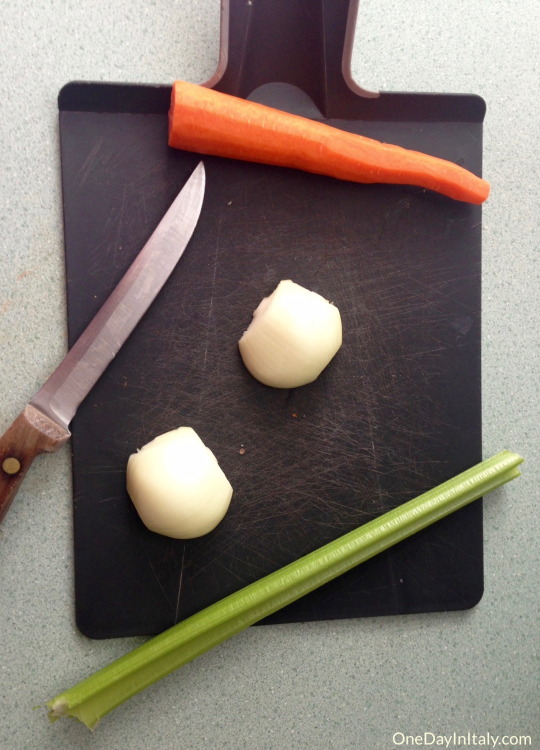
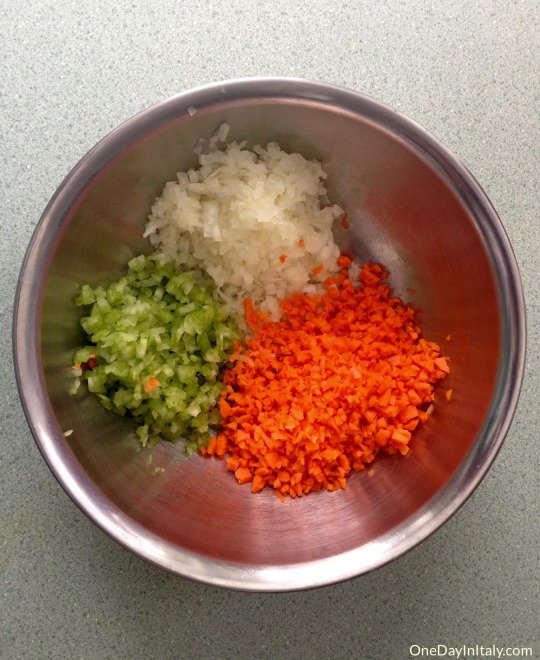
Put a bit of olive oil (a little over a tablespoon) in a pot and sautè the carrot, onion and celery over a low flame till the mixture is dry (the recipe says this will take at least 20 minutes).

Now, settle in. This is gonna take a while. Luckily for me, I had a lovely view out the kitchen window the morning after the east coast bilzzard.

Add the ground beef and ground pork. Mix everything together so it becomes a uniform mixture and brown the meat over a low flame, stirring continuously with a wooden spoon so it doesn’t stick to the bottom of the pan.
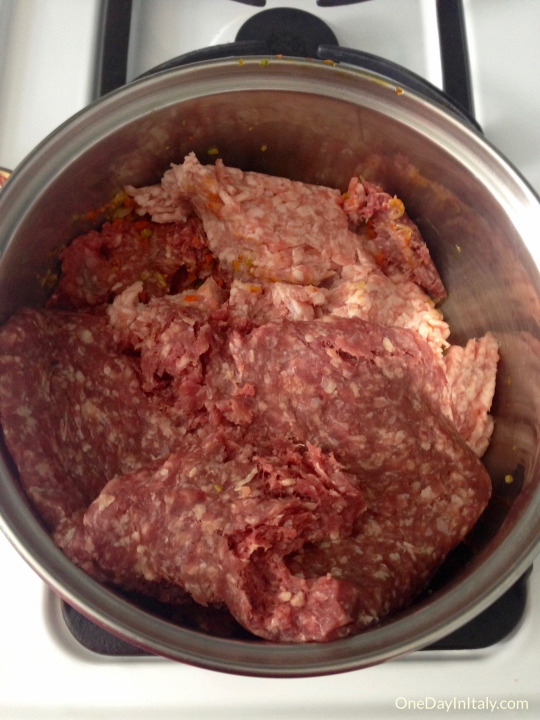
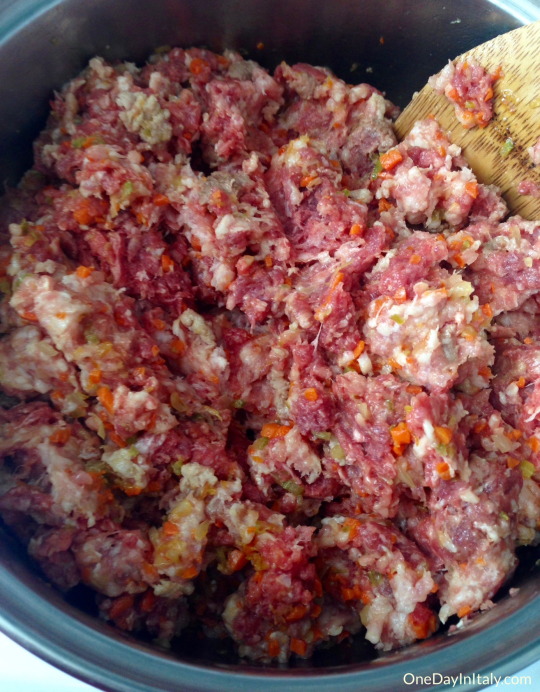
When the meat is well-browned and dry, add the wine. Now, when you’re stirring the meat it may seem dry, but before adding the wine do a simple test: clear a small area and count to five. If juices flood in (like in the first picture below), the mixture isn’t yet dry. The second picture shows a “dry” mixture (note: there will still be a tad bit of liquid, but the difference should be clear).

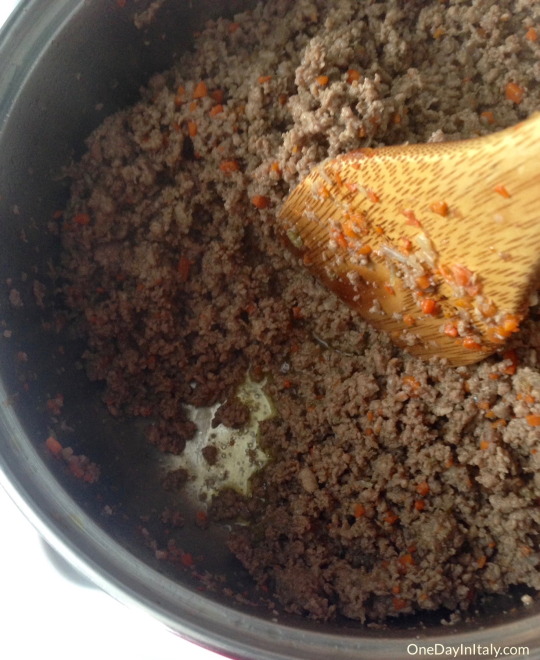
After you add the wine, let the mixture cook while you stir until it is, again, dry. Then add the 250g of tomato puree. Add a little bit of water to the container that held the pureè and shake it around a bit to get all of the tomato-y goodness off, then pour it into the ragù. Careful not to add too much water, as you’ll have to cook this down till the mixture is – you guessed it! - dry.
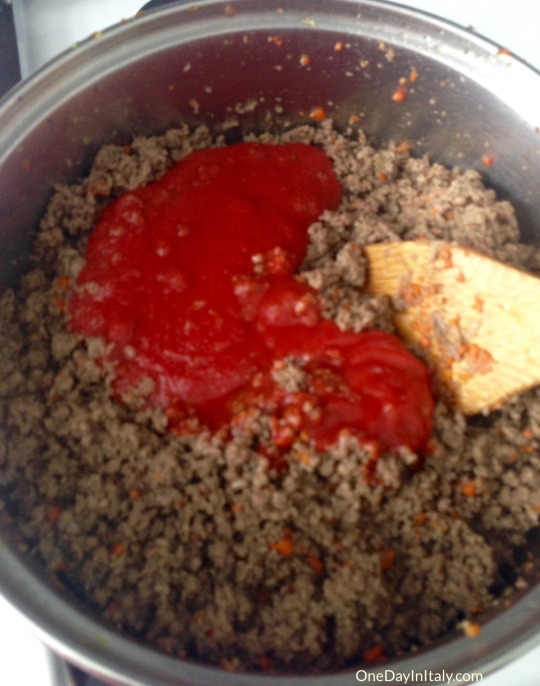
The picture below looks like a nice ragù, right?
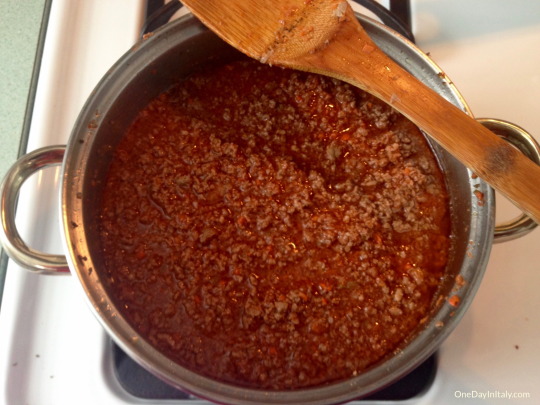
Wrong! At least, not for our purposes. If you let it sit for a minute, all of this liquid and grease will rise to the top. If you were to use the ragù at this point, the same thing would happen to your lasagna. Keep cooking; this is why it really needs to be dry.
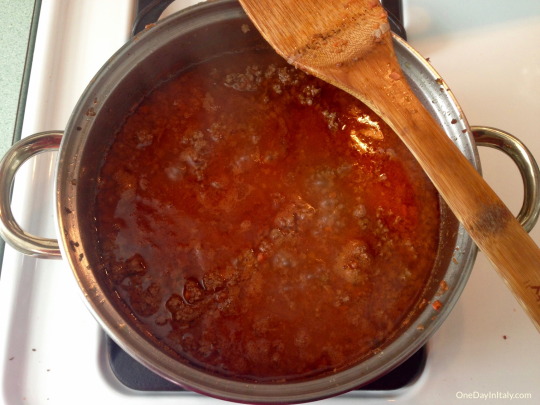
When the ragù is just about done, add the milk and stir to combine for a few minutes. Then you can remove it from the heat and set it aside while you make the bechamel.
This process also takes patience (1 liter is a lot of milk!) but will go much faster than the ragù, so have your lasagna pan ready. Go ahead and put the milk in the small pan on medium heat to warm it. Then, after giving the milk a chance to warm a bit, put the butter in the medium pot and melt it over a low-medium flame. Once it’s completely melted (but before it browns!), quickly take it off the flame and whisk in the flour so there are no lumps. Then return it to the flame, continuing the whisk it well, to brown it slightly (but not burn it).
Add the grated nutmeg to the warmed milk and stir. Then, add the milk mixture to the butter and flour. Continue to whisk it really well so the bottom doesn’t burn as you gently heat the bechamel. The recipe says it should only take about 5-6 minutes to thicken, but it took me almost 20 (and I had to raise the heat so that the mixture came to a gentle boil). Remember, you don’t want this bechamel to be so thick that it’s like a paste; you should be able to pour it.
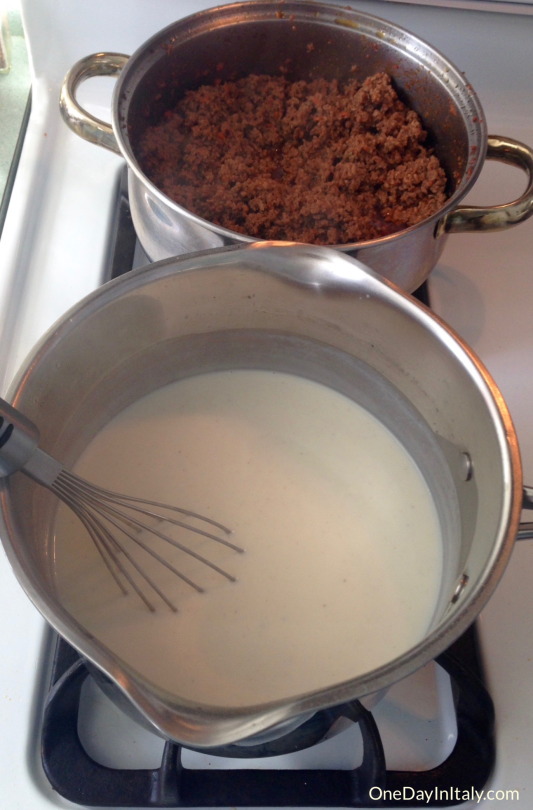
Once your bechamel has reached the desired consistency, you can begin layering your lasagna! Start with a thin layer of bechamel on the bottle so the noodles don’t stick to the bottom of the pan.
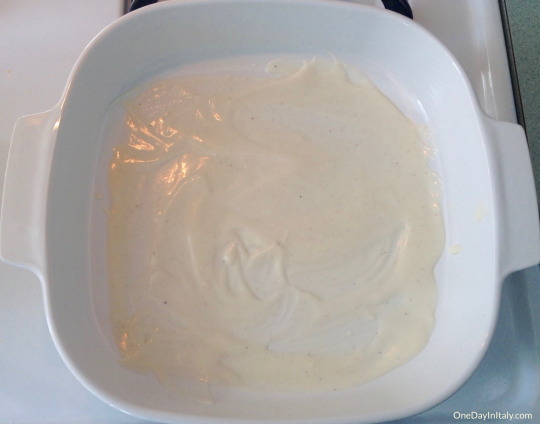
Then add a layer of noodles, overlapping them slightly (feel free to break them and piece them together if they don’t quite fit your pan). Over the noodles, add another layer of bechamel, a layer of ragù and a thin layer of grated Parmesan cheese. That will be the formula for the rest of the assembly process: noodles, bechamel, ragù, Parmesan. The recipe says to make 6 layers but my pan (and my ingredients) seemed to only allow for four. No biggie.
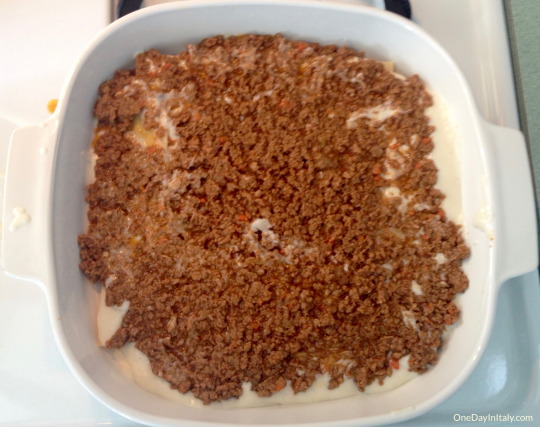
The last layer will end with a generous helping of cheese. If you have leftover bechamel, like I did, feel free to pour it along the edges to fill in any empty spaces in the layers.
Preheat your oven to 200°C (about 390°F). Then, follow the directions on your noodle box. The recipe says to bake for 25 minutes, uncovered, however after doing that, my noodles weren’t fully cooked. My noodle box said to bake for 35 minutes covered and then 25 minutes uncovered, so I put my lasagna back in the over for another 35 minutes, covering it for most of them and only uncovering it again for the last 10 minutes to make sure the crust was still crispy.
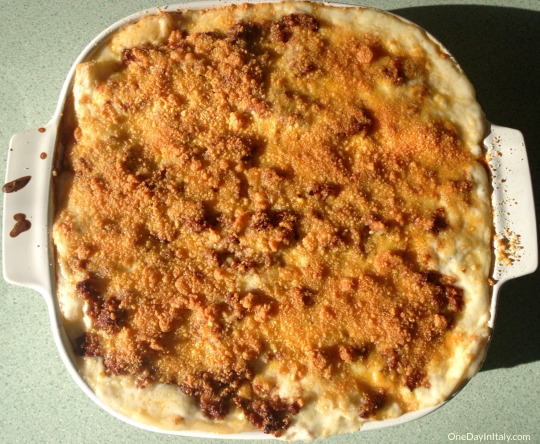
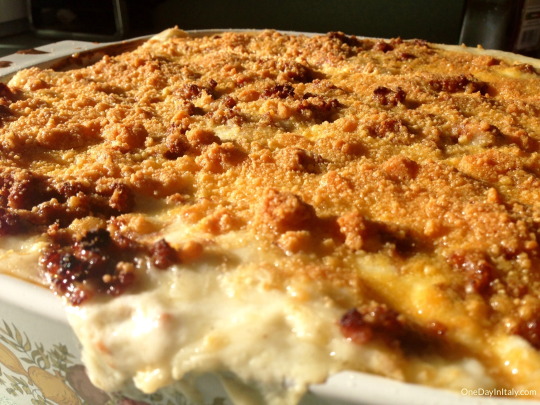
After letting it set for about 15 minutes, we cut into it and carefully disdhed out pieces of a really beautiful lasagna alla bolognese.
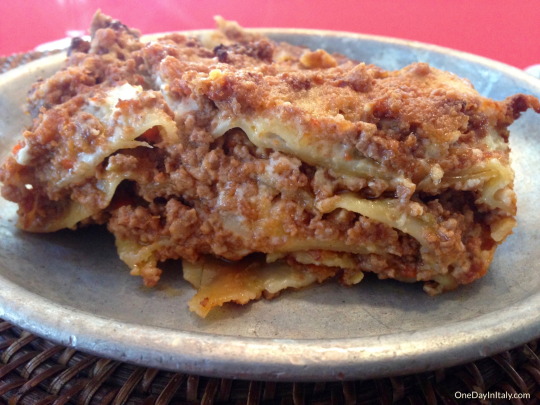
It was delicious! Perfect! I was so happy! My parents loved it too, even though they admitted to me that they had never eaten anything like it and had expected an “American” lasagna with tomato sauce, mozzarella and ricotta! My mother then said that she had never really liked homemade lasagna but had gone along with my dad’s request to be nice – but she loved this version and wanted the recipe!
So here it is; I hope you all enjoy it! It’s quite an impressive dish, reletively simple to make even though it is a bit time-consuming. If you make it, you’ll have to come back and tell me what you think – was it worth it?
I certainly thought so ![]()
Comments
comments











Leave a Reply